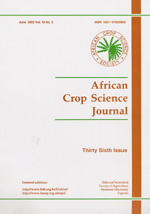
|
African Crop Science Journal
African Crop Science Society
ISSN: 1021-9730
EISSN: 1021-9730
Vol. 8, No. 2, 2000, pp. 117-127
|
 Bioline Code: cs00012
Bioline Code: cs00012
Full paper language: English
Document type: Research Article
Document available free of charge
|
|
|
African Crop Science Journal, Vol. 8, No. 2, 2000, pp. 117-127
| fr |
Sugiura, H.; Agong, S.G.; Enami, A.; Kaneko, H. & Honma, T.
Résumé
La croissance et le développement à partir des promordia des pousses et dembryoïde obtenus de lHybride Lily Asiatique et de lHybride Lily Oriental ont été étudiés. Le primordium des pousses et la formation dembryoïde de lHybride Lily asiatique étaient fructueux plus que l'Hybride Lilly Oriental. La concentration du milieu de la plus haute formation du primordium de pousses de lHybride Lily asiatique venu du méristeme apicale a été obtenu à 0.5 BA (6-benzylamonopurine) sans NAA (acide acétique de Naphtalène), et celui de l'Hybride Lily Oriental a exigé 0.01mg/l NAA et 0.5 mg/l BA. Les callis embryogéniques de lapex des pousses pour la germination de lembryoïde ont donné suite aux multiples embryoïdes, qui ont régénére très rapidement dans le milieu avec les mêmes concentrations de NAA et BA du milieu pour la formation du primordium des pousses. Les concentrations de NAA et de BA dans le milieu de regénération à partir des primordium de pousses et dembryoïde était similaires aux traitements pour la formation du primordium des pousses et dembryoïdes mais differaient entre l'Hybride Lily Asiatique et l'Hybride Lily Oriental. Des jeunes plantes régéneraient in vitro à partir du primordium de pousses et dembryoïdes acclimatés avec le maintien dhumidité. Seulement très peu de cas de mutation somaclonale ont été notés dans les plantes régénérées à partir du primordium des pousses et dembryoïde. Ainsi nos résultats suggèrent que des plantules produites par ces deux méthodes sont stables et la production commerciale par ce protocole est dune importance capitale pour la multiplication des plantes à fleur.
Mots Clés
Lily Asiatique, mutation, multiplication, primordia des pousses
|
| |
| en |
Comparison between Embryoid and Shoot Primordia Methods of Plantlet Production for'Asiatic Hybrid Lily'and'Oriental Hybrid Lily'
Sugiura, H.; Agong, S.G.; Enami, A.; Kaneko, H. & Honma, T.
Abstract
Growth and development from shoot primordia and embryoids obtained from the Asiatic Hybrid Lily and the Oriental Hybrid Lily were studied. Shoot primordium and embryoid formation of the Asiatic Hybrid Lily was more successful than the Oriental Hybrid Lily. The highest shoot primordium formation medium of the Asiatic Hybrid Lily from apical meristem was achieved at 0.5 BA (6-benzylaminopurin) without NAA (nafthalen acetic acid), and that of the Oriental Hybrid Lily required 0.01 mg/l NAA and 0.5 mg/l BA. Embryogenic calli from the shoot apex for embryoid germination gave rise to numerous embryoids, which regenerated rapidly in the medium with the same concentrations of NAA and BA in the medium for shoot primordium formation. Concentrations of NAA and BA in the medium for regeneration from shoot primordium and embrioids were similar to treatment for shoot primordium and embryoids formation but differed between the Asiatic Hybrid Lily and the Oriental Hybrid Lily. Young plants regenerated in vitro from shoot primordium and embryoids acclimatised with the maintenance of humidity. Only a few cases of somaclonal mutation were noted in the regenerated plants from shoot primordium and embryoids. Thus, our results suggest that plantlets produced by these methods are stable and commercial production via this protocol is feasible for lily propagation.
Keywords
Asiatic Lily, mutation, propagation, shoot primordia
|
| |
© Copyright 2000 - African Crop Science Society
|
|
